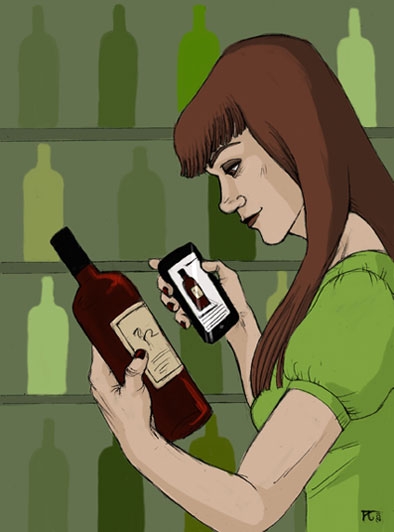Customers are increasingly frequently using their telephones to connect to the Internet within shops themselves, to obtain more information. (Image: Aina Albi / Artchandising)
ABSTRACT
More than “multichannel retailing”, think about giving customers more options and making things easier for them, whilst maintaining the brand experience.
Ahead of my talk on innovation at the World Retail Congress (Berlin, September 2011), I had the chance to see the subjects that aroused most interest at the largest world retail industry conference. The topic that attracted most managers was “multichannel retailing”.
The use of the Internet is already a reality. A growing number of individuals make purchases online and therefore companies also to think about accessing the public directly via the Internet besides doing it via physical stores. 37% of Spanish Internet users who shop online prefer to buy from companies that also have physical stores (Nielsen Co).
What is it all about
This sales strategy, usually often referred to as “multichannel retailing” is in reality, a multimethod retail sales strategy.
We are not simply talking about the addition of sales through computers, because – the scope is far wider: catalogues (don’t forget about of them yet!), smartphones (via Internet web or specific applications), telephone sales, TV infomercials, visits from sales representatives, multi-brand stores, single-brand stores, Horeca, multi-brand websites (vente-privee , letsbonus, privalia, etc.), places to pick up orders, vending machines, factory stores (such as the famous shop of the González Byass winery), etc.
In all these methods there are three elements: the money, the information that the customer requires in order to ponder and take his decision (product description, price, etc.), and thirdly the dispatch of the purchased goods, in other words the logistic flow.
What is interesting is that these three flows can either be realized out using the same method or being spread amongst several. In Korea, Tesco recently launched a kind of ‘virtual supermarket’, located on underground station platforms. (Whilst waiting for their train on the platform) , passengers can do some of their shopping by scanning the codes of the items they want to buy using their smartphone and then ordering on the train.
On the other hand, customers are increasing frequently using their telephones within the shops and connecting them to the internet to obtain more information.
Pros and cons
When a customer wants to buy a service or a product, they are far more likely to make the purchase if it is made easier for them; for example more options to buy or to get information.
It is important to remember that increasing convenience is a great way of increasing sales, even in a grim economic climate. For example, in Catalonia in 1995, the sales of theatre tickets rose by 59% after it became possible to buy them by phone.
There is statistical proof that, in general, if customers have more access methods, the turnover, the number of hard customers, the number of purchases per customer and the loyalty of those who make their purchases using the different media increases. (1) (2)
However, the side effects are far from negligible. There may be conflict between the types of business customers, the retail prices may vary, and the organisational complexity may increase.
Boundaries
Imagine you are using your smartphone because you have to provide guidelines for a negotiation process:
– You look at the company’s website and find interesting information.
– You use this information to make some calculations.
– Then you send send an e-mail to your colleague on how to negotiate.
– Finally, you write a personal note to remind you of the approach.
You have alternately been online and offline. Let me ask you a question: were you aware of when you were online or offline? I imagine that you simply felt it as using your smartphone. The perceptual boundaries between online and offline are becoming blurred. Therefore, if customers using those phones do not perceive these changes, what is the point to be either a “company.com” or a “company.brick”?.
The logical thing is simply to be a company which is focused on increasing customer value. For this purpose, we must put the customer-persons in the middle and allow them to access our company, in other words our information, products/services, using a large number of “bridges”: a physical store, website, telephone application, customer service phone line, vending machines, sales representatives who visit customers, etc.
Each bridge has its pros and cons. None of them is good or bad per se, simply suitable or less suitable for a specific type of customer. One customer might use a bridge to look for information, another to make purchases and yet another to pick up the product. For example, in Spain 29% of Internet users consult the web in order to get support in their purchasing decisions they will take when buying products or services at physical shops (Nielsen Co).
More specifically, a key variable determining the use of these methods is the type of product. For example, when it comes to furniture sales, 50% of customers use the Internet to look at products, then 62% buy their goods in a physical store, whilst 73% have it delivered to their home. (3)
Each bridge has its own specific characteristics
Due to its own individual nature, each “bridge” involves different levels of investment and cost. Normally, the public tends to accept price discrimination (charges or discounts) when using one method in preference to another. For example, if they go and collect themselves what they have bought online, they would not expect to be asked to pay transport costs.
Customers who use different methods to buy products/services (for example, purchasing Coca-Cola customers, can buy in supermarkets, in Horeca, in vending machines), buy more, improve their brand perception and do not mind so much that there are different prices (Professor Chiara Mauri, Coca-Cola research, Italy).
Moreover, the sequence in which new sales methods are launched is important, as the same Professor states in another case. For example, it is more logical to start selling in multi-brand stores and then, when the brand awareness is high, to launch single-brand stores. This sequence improves the brand image and increases its visibility.
Basically, it is a matter of putting the customers in the center and serving them no matter which sales method they choose. The customers will be happier, experiencing the brand more intensely, in a more multifaceted manner and this will increase their brand loyalty. (2)
The method that will become most important for accessing the Internet will be the smartphone, not only because more and more people now use them (smartphone searches increased by 181% in the first trimester of 2011), but because its proximity to the body makes it more convenient.
According to Google, 80% of a person’s purchases are made within a 4-km radius of their home. This fact, combined with the smartphone, is going to give rise to new, innovative, customer-centred retail business models.
In addition to this, when the convenience of a method increases, as in the case of tablets, its efficiency increases (iPad is giving UK retailers a 350% better sales conversion rate than the iPhone, according to the Just Eat chain).
However, physical stores have not become obsolete. They remain the most sensory means of expressing the brand and making people experience it; thus, if they are designed with an appropriate strategy, the result is brilliant to improve and to increase sales.
Management implications
What will become standard is not the mere co-existence of “channels”, but rather the design of an integrated system of communication-sales-logistics methods, like “bridges” between the company and the customers.
These have to be the real center. They have to feel that they are being taken into account and their brand experience (product or chain) is the same, whichever access method they decide to use at any given time.
The engine of this system will be Customer Relationship Management (CRM), because what really matters in order to increase the cash-flow is making the economic long-term value of a customer grow (lifetime customer value). The danger of obsessively focusing on average ticket amount is that the company may neglect important aspects of running a business.
Bibliography
(1) Morschett Dirk *, Zentes Joachim, Schramm‐Klein Hanna, Cross-Channel Integration – Is it valued by Customers? Paper at EAERCD Conference, Parma July 2011.
(2) Corey Yulinsky, McKinsey marketing practice. Multi-channel marketing. Making “bricks and clicks” stick. 2000.
(3) PwC UK. Pick ‘n’ Mix: Meeting the demands of the new multi-channel shopper, p.1-20. 2010.
_______________
Lluis Martinez-Ribes
Source: Código 84, (Burbujas de Oxígeno)




